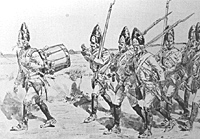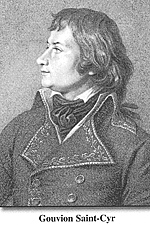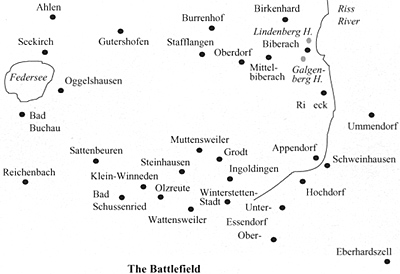First Battle of Biberach
2 October 1796
Moreau Retreats
by Jens-Florian Ebert and Roland Kessinger, Germany
| |
Moreau was therefore forced to orders his Army of the Rhine and Moselle to retreat from Bavaria in mid-September. The Centre corps under St. Cyr reached the Iller River on 24 September without disturbance from FZM Latour, while the Left Wing corps under Desaix had taken up a position near Ulm on the northern bank of the Danube. Before continuing his withdrawal westwards, Moreau concentrated his army between the Danube and Lake Constance by moving Desaix’ corps to the southern bank of the Danube near Ehingen during the night of 26/27th September. Moreau was undefeated and his army was intact, enjoying a large numerical superiority over Latour. Against his 55,000 men. Latour could only direct 46,000 (46 battalions, 3 companies, 90 sqdns), which were currently widely dispersed. Some Austrian battalions used by FML Fröhlich for his attack on Delaborde were formally part of the Austrian Army of Italy and were not allowed to leave the Vorarlberg. (western Austria), being required as a reserve for the defence of the Tyrol. To the north, GM Nauendorf’s 8 battalions and 30 squadrons were on the northern bank of the Danube. Attempting to make contact with FML Petrasch somewhere to the east of the Black Forest. However, Petrasch’s troops would remain in the area around around Rottweil and Villingen until early October and so, could not participate in the upcoming actions to the north of Lake Constance. So, Latour could deploy a force of just 25,300 infantry and 9,300 cavalry in 34 battalions, 3 companies and 59 squadrons between the Danube and Lake Constance at the end of September, which included 4,500 infantry and 1,900 cavalry in 3 1/2 battalions and 9 squadrons of the French emigre corps under Condé.
Gouvion Saint-Cyr FZM Latour crossed the Iller River at Illertissen with his main force over 27-28th September and followed Moreau, who took up a position with his Left Wing corps under Desaix and the Centre crops under St. Cyr near Bad Buchau on both sides of the Federsee lake. The Right Wing corps under Ferino was further south around Ravensburg along the Schussen River. The French rearguard still occupied the area between the Federsee and Biberach on 28th September. While the French had concentrated their forces, the Austrian units remained dispersed. GM Nauendorf Division, north of the Danube, was sending out cavalry patrols towards Stuttgart and Tübingen, in the south, the far left wing Division under FML Fröhlich faced Ferino’s corps near Ravensburg. Only the Austrian centre under the direct command of FZM Latour was east of Biberach on 28 September, from where it could be used to disrupt Desaix and St. Cyr’s retreat.
On 27 September in Bad Buchau, Moreau appears to have been informed about the occupation of the Black Forest passes by FML Petrasch and the popular uprisings. Now that Jourdan had evacuated Germany, it was to be expected that Petrasch would be steadily reinforced by the k. k. Niederrhein-Armee, which would further encourage the peasant rebellions in his rear. Moreau recognised that he had to hasten his retreat. Ferino could march uninterrupted westwards from Ravensburg along the northern bank of Lake Constance, while St. Cyr could follow the main road from Bad Buchau and Bad Schussenried towards Saulgau-Mengen-Messkrich. However, Desaix would either have to follow St. Cyr or cross the Danube once more near Riedlingen, as the area between Lake Constance and the Danube is more constricted west of the Federsee lake. If Desaix used the southern bank of the Danube heading for Mengen-Messkirch following St. Cyr, it would give FML Nauendorf free rein to operate on the northern bank of the Danube, so Desaix had to recross the Danube to allow Moreau to use his numerical superiority to cover a wide frontage and to prevent GM Nauendorf joining FML Petrasch. The crossing of a river in close proximity to the enemy is always risky, so Moreau decided to attack Latour at Biberach draw Austrian attention from Desaix’s crossing. Therefore, he kept his forces around the Federsee and along the Schussen River near Ravensburg over 29-30th September. The Austrian commander-in-chief’s plans are less clear and it seems that he was convinced that the French were continuing their retreat between 27th and 30th September, attempting to escape without any further engagements. Despite the casualties he had sustained in the fighting in Bavaria, Latour intended to follow his opponent and allow him no respite. Charles had taken his elite units, the Grendier battalions, when marching off north in August, so his brigades were mainly composed of individual battalions from different regiments, some numbering just 5-700 men. Nevertheless, after news of the victories in the north, army morale was good and the victory over Delaborde had further encouraged Austrian troops. Acting together with GM Nauendorf and FML Petrasch, FZM Latour hoped to drive the French back to the Rhine as quickly as possible, which would come as a great relief to the population of the Austrian territories in Swabia (Vorderöstrreich) currently under French occupation. The Armies on 29 September The Austrian Divisions under FML Petrasch (brigades under GM Kavayevich and Oberst Merverldt), GM Nauendorf and FML Fröhlich (brigades under GM Wolff and GM Klinglin) were too distant to join the engagement, so the First Battle of Biberach would only be fought by Latour’s own men: The advance guard under FML Ludwig Graf von Baillet de Latour (3 batts, 6 cos, 12 sqdns), the main force (Schlachtkorps – battle force) under FZM Latour himself (Divisions under FML Freiherr von Kospoth and FML Karl Aloys von Fürstenberg; 12 batts, 12 sqdns), plus a detachment under FML Karl Graf von Mercantin (4 batts, 10 sqdns) and near Biberach, the 3 1/2 battalions and 9 squadrons of the French émigré corps under Condé. On the French side, Ferino’s corps didn’t participate in the battle even though Ferino had orders to join the main force, so Moreau would engage with 21 battalions and 24 squadrons under Desaix (16,500 men, divided into Divisions under Beaupuy and Sainte-Suzanne) and the 24 battalions and 40 squadrons of St. Cyr’s corps (19,300 men, divided into Divisions under Taponier and Van-damme), together with the Reserve corps under General de Division Bourcier. 29 September: The Austrian Advance-guard Attacks The Austrian advance-guard under FML Baillet reached Biberach on 29 September. After a fierce outpost clash, the Austrians occupied the town and the hills west of the Riß River around the village of Grodt. During the day, FZM Latour took up a position with his force behind the advance-guard in and around Biberach.To cover his right flank between the Federsee and the Danube, Latour detached some companies of light infantry (presumably from the Szekler Grenzer Combined Battalion) and four squadrons from the advance-guard under Oberst Graf von Nostitz-Rieneck towards Ahlen, to observe the road from Riedlingen to Biberach. Latour had only deployed a small force here as he believed Desaix was still retreating. To guard his left wing, Latour ordered FML Mercantin to push forward to Mühlhausen with his Division. Three battalions from FML Fröhlich’s Division, which were positioned north of Lake Constance, were moved up to Wolfegg to support the advance of the main force and to cover Mercantin’s left. However, Latour made no effort to co-operate with GM Nauendorf on the northn bank of the Danube, which later events would prove to be a major error. 30th September: Clashes Around Steinhausen – St. Cyr Against Baillet While the Austrians crossed the Riß River, Desaix and St. Cyr remained in position between the Bussen Hill and Bad Schussenried. Contrary to Moreau’s intentions, the left Division of Ferino’s corps under General de Brigade Abatucci had headed away from Bad Waldsee in the direction of Ravensburg on 29 September, as Abatucci was attempting to sup-port the far right brigade of Ferino’s corps under General de Brigade Paillard, which had been attacked by FML Fröhlich near Tettnang that day. Latour remained convinced that the Army of the Rhine and Moselle was retreating and wouldn’t offer significant resistance, so he ordered a general advance for 30th September. His younger brother, FML Baillet, was to push forward with his advance guard along the road to Bad Schussenried; the detachment under Col. Nostitz was to march westwards over Ahlen, while FML Mercantin advanced from Mühlhausen in the direction of Aulendorf. Soon after FML Baillet had moved out of Steinhausen along the road to Bad Schussenried during the early morning of the 30th, Vandamme’s outposts (St. Cyr’s corps) retreated westwards. However, it was only a feint! Carelessly and encouraged by his initial success, FML Baillet stormed forward along the road, only to find himself suddenly under attack from the whole of St. Cyr’s Centre corps. Lecourbe’s brigade was threatening his flank and Baillet was quickly thrown back to the hills west of Steinhausen. Here, FZM Latour sent additional troops to his younger brother from the Schlachtkorps around 3 p.m. and together, the brothers were able to hold the hills until nightfall amidst heavy fighting. In a letter to FML Fröhlich, the Austrian commander-in-chief wrote on 1st October from Grodt that during the fighting around Steinhausen on the day before, he had lost 131 dead, 420 wounded, and 300 prisoners. IR17 Hohenlohe and IR35 Wenkheim had suffered particularly heavily, a prominent casualty being the fatally wounded Obristwachtmeister (Lt.-Col.) Eduard Graf von Wallis from IR 35. Part of Condé’s émigrés under the command of Antoine Louis Henri de Bourbon-Condé, duc d’Enghien had fought here too, losing 7 dead and 43 wounded. There’s no exact information about the losses of the Army of the Rhine and Moselle, but it is reasonable to assume that the French had sustained approximately the same losses. According to a report from an eyewitness from Biberach several hundred French prisoners were marched through the town during the next day. 30th September: Further Clashes Near Ahlen and Michelwinden The detachment under Oberst Nostiz fared no better north of the Federsee than the advance-guard had. After this weak force had left Ahlen, it was attacked by Desaix’ artillery, forcing the Austrians to withdraw quickly back the way they had come. FZM Latour now had to detach the bulk of his Schlachtkorps (6 batts, 6 sqdns) under FML Kospoth from Biberach to Stafflangen to support Oberst, while the much of the rest had been deployed in support of FML Baillet near Steinhausen, leaving FZM Latour with just a small force on the hills above Groth. FML Mercantin was only able to advance with his Division from Mühlhausen to Michelwinden, where larger French forces from St. Cyr’s corps halted him. 1st October: Lull Before the Storm The heavy fighting on 30th September made it clear to Latour that the Army of the Rhine and Moselle would not just retreat without significant resistance and was probably planning a counterattack. So he tried to concentrate his troops between the Danube and Bad Waldsee east of the Federsee lake, the main part being assembled southeast of the Federsee, where he appears to have expected the most French resistance, given the fighting over the previous days between Bad Buchau and Bad Schussenried. During the night of 1st/2nd October, he positioned his troops: FML Kospoth with 6 battalions, 3 companies, and 10 squadrons (4,664 infantry, 1,452 cavalry) formed the right wing around Stafflangen, occupying the forests towards Oggelshausen and Seekirch east of the Federsee. From here, he could cover all the roads to Biberach north of the Federsee and support the Oberst Col. Nostitz, then east of Ahlen. Of Kospoth’s 6 battalions, two together with three guns were Bavarian, and represented most of the Imperial contingent troops still fighting on the Austrian side in the autumn of 1796. On the far right wing, ten squadrons were concentrated under GM Devay to observe the Danube Valley near Marchtal. FML Baillet’s advance-guard and a part of the Schlachtkorps, (a total of 6 1/2 battalions and 12 squadrons - 3,768 infantry and 1,436 cavalry) formed the centre on the hills north of Steinhausen. Baillet’s right between the hills north of Steinhausen and the Federsee seems to have been protected by marshy ground. FZM Latour stayed with a small reserve of 3 battalions and 2 squadrons (1,954 infantry and 266 cavalry) on the hills above Grodt, a few kilometres east of Steinhausen. After the earlier engagements near Michelwinden, FML Mercantin and Condé’s émigrés had moved northwards towards FML Baillet and with their 7 1/2 battalions and 19 squadrons (6,574 infantry, 3,327 cavalry) formed the left wing behind Olzreute. FML Fröhlich (near Ravensburg) and GM Nauendorf (on the northern bank of the Danube near Ehingen) were not given any orders and would not participate in the battle. All together the Austrian army (incl. the Bavarian troops and the corps Condé) at Biberach was 23,441 men strong (16,960 infantry and 6,481 cavalry). Latour lacked Freikorps troops for light infantry duties and Grenadiers for an elite reserve, nor did he have any heavy cavalry - GM Nauendorf’s mobile Division on the northern bank of the Danube was mostly composed of cavalry units, including 22 squadrons of Kurassier. Latour’s position was poor for both defence and taking the offensive. The Federsee lake divided the army in two, which could easily be outflanked to both sides. If the defensive line broke at any point, the route to Biberach stood open and the French could quickly get into the Austrian rear. Moreau’s Plans for 2nd October By this stage, Moreau must have realised that the Austrians held a poor position, as he decided to launch an attack on 2 October, designed to allow him to escape his pursuers and reach the safety of the Black Forest. So, while his army rested in its positions during 1st October, Moreau and his Chief of Staff General de Brigade Reynier were working out the plans for the attack by all four corps towards Bad Buchau. The attack would have to start along both sides of the Federsee: General de Division Desaix would advance with his two Divisions – a total of 21 battalions and 24 squadron (16,500 men) - from the Bussen Hill to Ahlen, north of the Federsee; then he would storm Ahlen and push FML Kospoth back to Biberach. St. Cyr’s Centre corps with 2 divisions and the Reserve corps under General de Division Bourcier - 24 battalions and 28 squadrons (19,300 men) in total – would march south of the Federsee towards Steinhausen in the general direction of Biberach. The French army had 35,800 men (33,000 infantry, 2,800 cavalry) available in total. Ferino, who still was along the Schussen River near Ravensburg, was to march northeast with parts of his corps and around Oberesendorf, fall on the flank and rear of Mercantin – unfortunately, he would receive his orders too late and therefore would not participate in the battle. First Battle of Biberach 2 October 1796 Back to Table of Contents -- First Empire # 70 Back to First Empire List of Issues Back to MagWeb Master Magazine List © Copyright 2003 by First Empire. This article appears in MagWeb (Magazine Web) on the Internet World Wide Web. Other articles from military history and related magazines are available at http://www.magweb.com |
 Despite his own advance, the commander-in-chief of the Army of the Rhine and Moselle faced a difficult situation at the end of September: Jourdan’s Army of the Sambre and Meuse was in chaotic retreat; the far right wing of his own army had been pushed back to Lake Constance; an Austrian Division was operating across his rear and the countryside behind him was in open revolt.
Despite his own advance, the commander-in-chief of the Army of the Rhine and Moselle faced a difficult situation at the end of September: Jourdan’s Army of the Sambre and Meuse was in chaotic retreat; the far right wing of his own army had been pushed back to Lake Constance; an Austrian Division was operating across his rear and the countryside behind him was in open revolt.
 27th & 28th September: The Armies Concentrate
27th & 28th September: The Armies Concentrate
 Opposing Plans
Opposing Plans